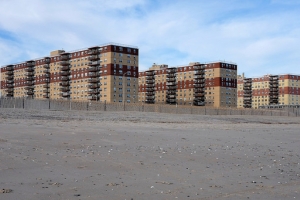Support migrant centric journalism today and donate

The population of the United States hit the 300-million mark officially on 17 October, a milestone set to generate little celebration. Unlike the pomp and circumstance that greeted the 200-million mark in 1967, federal officials this year are not planning any major events to welcome the 300 millionth American, who many say will likely be Hispanic, possibly an illegal immigrant, but more likely to be a legal immigrant.
The world's third most populous country behind China and India, the United States has 5% of the world's population. The United States adds another person to its population every 11 seconds. It is statistically estimated that the population hit the 300 million mark at 7:46 a.m. U.S. EDT -- 39 years after the U.S. population reached 200 million.
A spokesman at the Census Bureau said an announcement will be made to mark the coming milestone but there will be no celebrations of the scale organized by President Lyndon Johnson for the 200-million benchmark.
One reason is that illegal immigration is a hot-button topic that has sparked huge debate across the United States and is a key issue in upcoming legislative elections in November.
"There is nothing to celebrate, unless you think high housing costs and remarkable congestion and school overcrowding are reasons for celebration," said John Keely, spokesman for the Center for Immigration Studies, a conservative Washington think-tank that seeks tighter immigration controls. "And much of that is linked to immigration and rapid population growth."
There is also concern about the environmental impact of the growing population, which is expected to reach 420 million by 2050, then go onto reach 600 million by the end of the 21st century.
"This 300 million mark is a good time for us to focus attention on the US population and its environmental impacts," said Vicky Markham, director of the Center for Environment and Population, based in Connecticut. "In some ways you have to appreciate the kind of growth and prosperity in your country but on the other hand I see what kind of implications this has for the natural environment.
"Land is developed at twice the rate of population growth today," Markham said. "In other words, each American occupies 20 percent more developed land, for things like housing, schools and roads and shopping centers, than they did two decades ago."
According to census figures, about half of the growth since 1967 has come from Hispanics whose demographic growth by far has outpaced African-Americans', and accounts today for 14% (42.7 million) of the US population. That figure is set to increase to 25%, or 102.6 million, by 2050, according to the Census Bureau.
It is also expected that in the next 50 years there will be more Hispanic births in the United States than immigrants.
The U.S. population has jumped in the past decade, after taking until 1915 to reach 100 million. In the time it has taken for the U.S. population to grow to 300 million from 200 million, the world population has jumped to 6.5 billion from 3.5 billion.
Americans now live an average 77.8 years, compared to 70.5 years in 1967. About 85 percent of the population now has at least a high school education, compared to about 51 percent in 1967.
"What the new population growth represents is a return to our immigrant past," said William Frey, a demographer at the Brookings Institution in Washington and a professor at the University of Michigan.
He said although today's baby boomers, who make up 26% of the population, have put their mark on the US identity in the last decades and control the main positions of power, that will no longer be the case as the younger immigrant population ages.
"It will be a gradual change before we see the positions of power being taken by the new immigrants groups but I think it will happen, maybe in 20 years," Frey said.
He said the changing ethnic makeup of the United States and the new immigrants should be welcomed, rather than scorned, as they represent the future of the country.
"I think the political battle over immigration policy is short-lived and we will realize the positive impacts immigrants bring to the labor force," Frey said. "Something about our heritage as an immigrant country will allow this to happen."
He predicted that the United States in the next 20 years could also see its first Hispanic president elected.
"I think that's possible, but maybe by the time that happens we won't call him a Latino, we'll just call him an American," he said.
Related:
• US population to hit 300 million in October, 2006• US immigration has a positive effect on wages
• US labor market statistics correction, more vibrant than expected
• US economic and jobs statistics for August
• US study - Immigrants probably don't take jobs from Americans





















